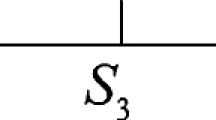Abstract
Ecological exploitation research generally holds that cooperation alliances form without restrictions and the information within alliances is known exactly. However, these assumptions do not always accord with reality. The main aim of this paper is to develop a more realistic approach in order to analyze alliance formation and profit allocation from ecological exploitation. We define an extended fuzzy graph cooperative game, in which players partially participating in coalitions and payoffs are fuzzy numbers, called bi-fuzzy graph cooperative game. The average tree solution (short for A-T solution) based on players’ risk preferences is proposed for this cooperative game, and the existence of the solution is proved. This paper can demonstrate that the players’ profitability depends not only on their marginal contribution degree to the coalition, but also on the communication structure and players’ positions in coalitions of a cooperative game.
Similar content being viewed by others
References
Girard, C., Rinaudo, J.D., Pulido-Velazquez, M.: Sharing the cost of river basin adaptation portfolios to climate change: insights from social justice and cooperative game theory. Water Resour. Res. 52(10), 7945–7962 (2016)
Jiang, Y., Hellegers, P.: Joint pollution control in the Lake Tai Basin and the stabilities of the cost allocation schemes. J. Environ. Manag. 184, 504–516 (2016)
Parrachino, I.: Cooperative game theory and its application to natural, environmental and water resource issues. World Bank Publications, Washington (2006)
Kyriazi, Z., Lejano, R., Maes, F., Degraer, S.: A cooperative game-theoretic framework for negotiating marine spatial allocation agreements among heterogeneous players. J. Environ. Manag. 187, 444–455 (2007)
Patrone, F., Sanchez-Soriano, J., Dinar, A.: Does game theory have a role to play in policy making in natural resources and the environment? Int. Game Theory Rev. 10(03), 221–228 (2008)
Li, D.F.: Models and Methods for Interval-Valued Cooperative Games in Economic Management. Springer, Cham (2016)
Abed-Elmdoust, A., Kerachian, R.: Water resources allocation using a cooperative game with fuzzy payoffs and fuzzy coalitions. Water Resour. Manag. 26(13), 3961–3976 (2012)
Liu, J., Zhao, W.: Cost-sharing of ecological construction based on trapezoidal intuitionistic fuzzy cooperative games. Int. J. Environ. Res. Public Health 13(11), 1102 (2016)
Myerson, R.B.: Graphs and cooperation in games. Math. Oper. Res. 2, 225–229 (1977)
Jiménez-Losada, A., Fernández, J.R., Ordóñez, M.: Myerson values for games with fuzzy communication structure. Fuzzy Set Syst. 213, 74–90 (2013)
Fernández, J.R., Gallego, I., Jiménez-Losada, A., Ordóñez, M.: Cooperation among agents with a proximity relation. Eur. J. Oper. Res. 250(2), 555–565 (2016)
Li, X., Sun, H., Hou, D.: On the position value for communication situations with fuzzy coalition. J. Intell. Fuzzy Syst. 33(1), 113–124 (2017)
Herings, P.J.J., Van Der Laan, G., Talman, D.: The average tree solution for cycle-free graph games. Game Econ. Behav. 62(1), 77–92 (2008)
Talman, D., Yamamoto, Y.: Average tree solution and subcore for acyclic graph games. J. Oper. Res. Soc. Jpn. 51(3), 203–212 (2008)
Herings, P.J.J., van der Laan, G., Talman, A.J.J., Yang, Z.: The average tree solution for cooperative games with communication structure. Game Econ. Behav. 68(2), 626–633 (2010)
Béal, S., Rémila, E., Solal, P.: Rooted-tree solutions for tree games. Eur. J. Oper. Res. 203(2), 404–408 (2010)
van den Brink, R., Herings, P.J.J., Van Der Laan, G., Talman, A.J.J.: The average tree permission value for games with a permission tree. Econ. Theory 58(1), 99–123 (2015)
Mishra, D., Talman, A.J.J.: A characterization of the average tree solution for tree games. Int. J. Game Theory 39(1–2), 105–111 (2010)
Nie, C.P., Zhang, Q.: Fuzzy average tree solution for graph games with fuzzy coalitions. In: Cao BY., Nasseri H. (eds) Fuzzy Information and Engineering and Operations Research and Management, pp. 409–417. Springer, Heidelberg (2014)
Xu, G., Li, X., Sun, H., Su, J.: The Myerson value for cooperative games on communication structure with fuzzy coalition. J. Intell. Fuzzy Syst. 33(1), 27–39 (2017)
Jafarzadegan, K., Abed-Elmdoust, A., Kerachian, R.: A fuzzy variable least core game for inter-basin water resources allocation under uncertainty. Water Resour. Manag. 27(9), 3247–3260 (2013)
van den Brink, R., He, S., Huang, J.P.: Polluted river problems and games with a permission structure. Game Econ. Behav. 108, 182–205 (2018)
Fodor, J.C., Roubens, M.R.: Fuzzy Preference Modelling and Multicriteria Decision Support, vol. 14. Springer, Berlin (2013)
Li, K.W., Inohara, T., Xu, H.: Coalition analysis with preference uncertainty in group decision support. Appl. Math. Comput. 231, 307–319 (2014)
Shapley, L.S.: A value for n-person games. Contrib. Theory Games 2(28), 307–317 (1953)
Yager, R.R.: OWA aggregation over a continuous interval argument with applications to decision making. IEEE Trans. Syst. Man Cybern. B 34(5), 1952–1963 (2004)
Aubin, J.P.: Mathematical Methods of Game and Economic Theory. Courier Corporation, North Chelmsford (2007)
Tsurumi, M., Tanino, T., Inuiguchi, M.: A Shapley function on a class of cooperative fuzzy games. Eur. J. Oper. Res. 129(3), 596–618 (2001)
Butnariu, D., Klement, E.P.: Triangular Norm-Based Measures and Games with Fuzzy Coalitions, vol. 10. Springer, Berlin (2013)
Kilgour, D.M., Hipel, K.W., Fang, L., Peng, X.J.: Coalition analysis in group decision support. Group Decis. Negot. 10(2), 159–175 (2001)
Acknowledgements
This research was partially supported by the Natural Science Foundation of China (Nos. 71572040, 71601049), the Science Foundation of Ministry of Education of China (No. 19YJC630201), the Project for Ecological Civilization Research of Fujian Social Science Research Base (Nos. KXJD1813A,KXJD1837A), the Program for Distinguished Young Scholars in University of Fujian Province (No. K80SCC55A), and the Project of Fujian Agriculture and Forestry University (Nos. XJQ201635, CXZX2017407, CXZX2017577). We appreciate the comments and suggestions given by the reviewers and editor of this journal.
Author information
Authors and Affiliations
Contributions
JY conceived, designed, and wrote the manuscript; JY and MK provided relevant information and corrected the manuscript. All the authors have read and approved the final manuscript.
Corresponding author
Ethics declarations
Conflict of interest
The authors declare no conflict of interest.
Rights and permissions
About this article
Cite this article
Yang, J., Kilgour, D.M. Bi-fuzzy graph cooperative game model and application to profit allocation of ecological exploitation. Int. J. Fuzzy Syst. 21, 1858–1867 (2019). https://doi.org/10.1007/s40815-019-00684-0
Received:
Revised:
Accepted:
Published:
Issue Date:
DOI: https://doi.org/10.1007/s40815-019-00684-0




